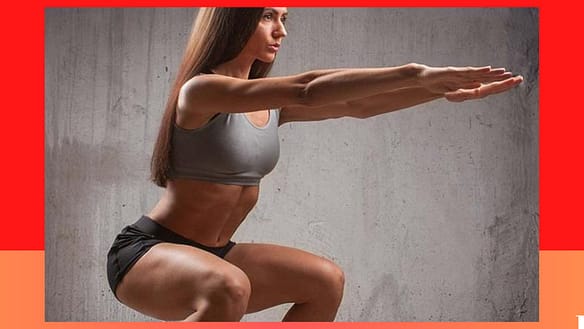Struggling with maintaining balance while squatting? Don’t worry, you’re not alone! Discover the surprising reasons behind your balance issues and how to overcome them.
Maintaining balance while squatting can be challenging for several reasons. One possible cause is a lack of core strength and stability, which can cause the torso to shift forward or backward. Weak glute muscles can also affect balance and stability during squats. Additionally, improper foot placement or distribution of weight can cause instability. It’s important to focus on proper form and technique, including keeping the chest up, pushing the knees out, and maintaining a neutral spine. Practicing with lighter weights and gradually increasing intensity can also help improve balance and stability.
Maintaining balance while squatting can be downright frustrating and disheartening, especially if you’re putting in the effort but still struggle to maintain proper form.
One possible culprit for this struggle could be a lack of core strength and stability, leaving you feeling unsteady and unsupported.
The feeling of your torso shifting forward or backward can be alarming and leave you feeling like you’re on the verge of falling over.
Don’t give up hope, though! With consistent practice and attention to proper form, you can strengthen your core muscles and improve your balance, allowing you to feel confident and stable during squats.
Remember to take it slow and gradually increase the intensity of your workouts.

Weak glute muscles can also affect balance and stability during squats.
Improper foot placement or distribution of weight can cause instability.
Feeling like you’re about to topple over during squats can be a frustrating and demoralizing experience. If you’re struggling with balance and stability, don’t forget to examine your foot placement and weight distribution.
It can be easy to overlook these factors, but they play a crucial role in maintaining proper form during squats.
It’s disheartening to realize that something as seemingly minor as the position of your feet can affect your ability to perform this exercise effectively.
However, take heart – by paying attention to your form and making adjustments as needed, you can improve your balance and stability and feel more confident and capable during squats.
Focus on proper form and technique.
The importance of proper form and technique when it comes to squats! don’t overlook the critical role that good form plays in this exercise.
It’s tempting to rush through squats, but focusing on details like keeping your chest up, pushing your knees out, and maintaining a neutral spine can make all the difference in your ability to maintain balance and stability.
It’s not always easy to maintain perfect form, but by paying attention to the little details and practicing consistently, you’ll be able to perform squats with confidence and ease. Keep up the hard work!
Practicing with lighter weights and gradually increasing intensity.
It can be discouraging to struggle with balance and stability during squats, but don’t forget the power of starting small and building up gradually.
It’s tempting to jump right into heavier weights, but that can actually hinder your progress and make it harder to maintain good form.
By starting with lighter weights and gradually increasing the intensity, you give your body the time it needs to adjust and build strength.
It’s not always easy to take things slow and steady, but trust the process! With patience and perseverance, you’ll improve your balance and stability and be able to take on more significant challenges in the future. Don’t give up – you’ve got this!
Final thought
In conclusion, maintaining balance when squatting is a common struggle that many people face, but it’s not something that should hold you back from achieving your fitness goals.
By understanding the basic mechanics of a squat and identifying your limitations, you can take steps to improve your balance and stability.
Remember, progress takes time, so be patient and kind to yourself as you work towards a better squat. Don’t let the fear of falling or injury keep you from trying, because the rewards of a well-executed squat are well worth the effort. Keep pushing yourself, stay motivated, and most importantly, enjoy the journey towards a stronger, healthier you!
Q&A
Why squat deeply if I don’t need to hit certain joint angles for my sport?
The idea of specificity makes this sound quite logical, yet it is not accurate. If you’re a speed-power athlete, your deep hip, knee, and ankle postures will be caused by acceleration mechanics.
To dash, you must accelerate quickly. Deep squatting can also strengthen the hip, knee, and ankle, reducing the risk of injury.
Why is it simpler to standardize deep squats?
When you’re down, you’re down. I deem a squat to be adequately deep when the hip crease is lower than the plane of the top of the knee.
It is typically simpler to ride the squat to the bottom after reaching this angle.
Most athletes can “bounce” out of the base once depth is reached, thanks to preloading the hamstrings and hips.
Related article:
What Not To do when squatting? (7 Most important things NOTE)

Hey there, it’s Mike Rrsq, the Editor-in-Chief over at Jsquat.com, and I’m absolutely obsessed with all things squat fitness! I’ve been lucky enough to get some serious recognition for my work in this field. With a solid background in the fitness and wellness industry, I’ve been there right from the get-go, helping shape this website into what it is today.
You see, I’m not just the boss around here; I’m also a passionate contributor. I love sharing my insights through my articles, and trust me, they’re not your run-of-the-mill stuff. Each piece I write is a labor of love, filled with my expertise and real-world experience in the fitness universe. So, if you’re into fitness and looking for some inspiration, you’re in the right place!

